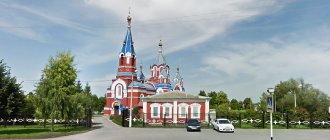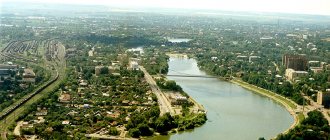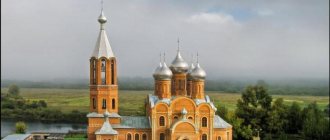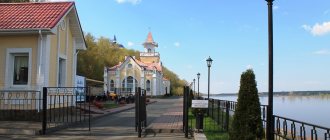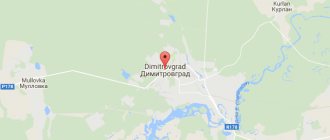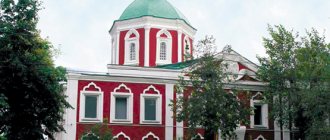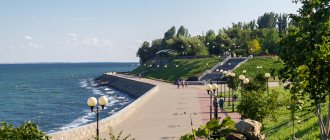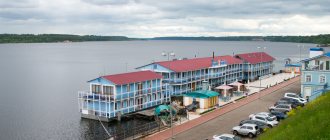| Kineshma. city panorama |
Kineshma
, a city in Russia, the administrative center of the Kineshma district of the Ivanovo region, within the Kineshma deanery of the Kineshma diocese. Located on the right bank of the Volga (port), 105 km northeast of Ivanovo. Railway station of the Yaroslavl region of the Northern Railway. Population - 81 thousand people. (2020)
- On the map: Yandex.Map, Google map
Kineshma was first mentioned in 1429 as a significant settlement, when it was plundered and burned by the Tatars.
In the first half of the 15th century, it was a stronghold guard post protecting Russian lands from raids, as well as an administrative and territorial center. In 1536, 1537 and 1539 the city suffered from raids by the Kazan Tatars. From the beginning it was mentioned in the 16th century as the village of Kineshma; name by location on the river Kineshma.
In 1482, the Grand Duke of Moscow John III Vasilyevich gave Kineshma as an inheritance to Prince F.M. Belsky. In 1581, Ivan IV the Terrible gave Kineshma to Prince I.P. Shuisky for his successful defense of Pskov from the troops of the Polish king Stefan Batory. After Shuisky was exiled to the Kirillo-Belozersky Monastery, Kineshma was returned to royal possession in 1587.
In 1608-1612, the residents of Kineshma fought against the Polish invaders.
In 1616, Kineshma was a district center, the main population was small artisans and traders (the main professions were butchers, fishmongers, honey makers, candle makers, blacksmiths, dyers, stove makers, shoemakers). Products manufactured in Kineshma went to the neighboring cities of the Volga region and Moscow.
In 1708 - as part of the Arkhangelsk province, from 1719 - in the Yaroslavl province of the St. Petersburg province. Since 1727 - in the same province as part of the Moscow province.
In 1777, the settlement of Kineshma was transformed into the county town of Kineshma, Kostroma province, and from 1778 - the county town of the Kostroma region, Kostroma governorate (since 1796 - Kostroma province).
Kineshma is one of the oldest industrial centers in the Upper Volga region. From the beginning of the 18th century, flax weaving developed (in 1758, the merchant Ivan Talanov built the first linen factory with 60 machines, employing 500 people). At the beginning of the 19th century, cotton production emerged.
In 1856, in the county town of Kineshma, Kostroma province, there were 9 churches, 497 houses, 73 shops.
In 1871, the railway connected Kineshma with Moscow, which created favorable conditions for further development and trade. In the second half of the 19th century, chemical plants (for the production of dyes, vitriol), an iron foundry, woodworking and other enterprises were built. Furrier, sheepskin and sleeping crafts were common. By the end of the 19th century, the city became one of the major textile centers of Russia (in 1913 there were 8 cotton factories).
In 1898, the Drama Theater named after. A.N. Ostrovsky
In 1914, there were 68 factory enterprises.
Kineshma is the second city in Ivanovo region in terms of population and industrial importance (over 20 large industrial enterprises). The city stretches for 24 km along the right bank of the Volga.
The old part of the city is located on a peninsula (in the 15th century - the Kokuy settlement, surrounded by an earthen rampart with a wooden wall and deep ditches, beyond its borders - a settlement).
A boulevard runs along the Volga embankment, above which rise the Assumption Cathedral (1745) with a bell tower (1798), the Trinity Cathedral (1836, architect I.E. Efimov), and the Ascension Church (1760). Among the civil buildings, the former linen factory of the merchant Talanov (1758) has been preserved. On the territory of the city market there is the Holy Cross Chapel (1744) on the Mass Grave of the city defenders who died in 1609 in the battle with the Poles.
The city has an art gallery and an art and history museum.
City universities: Ivanovo State Textile Academy (Kineshma branch), Kineshma branch of the Modern Humanitarian Academy, Moscow State Industrial University (Kineshma branch)
Story
Coat of arms (1779)
Kineshma in the magazine “Niva”, 1891
Base
The exact date of foundation of Kineshma is unknown. The first written mentions of Kineshma date back to 1429, when it was destroyed by the Tatars. At the end of the 15th century, Kineshma, with the city of Lukh, was given into the possession of Prince F. M. Belsky (according to other sources, in 1504 Kineshma was granted to Prince F. M. Volsky by Ivan III, and then by Ivan the Terrible to Prince I. P. Shuisky, after whose death in 1587 it returned to the royal possession).
In 1504 and 1539, Kineshma is mentioned in sources as a rural settlement. Initially, Kineshma was a small settlement, whose residents were engaged in fishing for themselves and the sovereign; then it grew and formed a suburb. In one of its parts, the Yamskaya Sloboda (later Zarechye1 or Turuntaevka), lived coachmen, whose family descended from Turuntai Pronsky and who belonged to the class of armored boyars. At the beginning of the 20th century, traces of an earthen rampart and a dry ditch remained.
Time of Troubles
During the Time of Troubles, the Kineshma militia, led by governor Fyodor Boborykin, took part in battles against the invaders. On the territory of the modern city, three major battles took place with detachments of Poles and traitors who joined them from the Moscow principality of Lisovsky and Tyshkevich. The Kineshma militia was defeated twice; as a result of one of the battles (on the site of the current Revolution Square), the city was completely destroyed. During the battle, part of the population (women and children) took refuge in a wooden church; by order of Lisovsky, the church was burned along with everyone who took refuge in it. The burial places of the dead (in the city) and battles are marked by chapels on Revolution Square (Krestovozdvizhenskaya Chapel), on Vichugskaya Street, next to the former machine-building plant named after. Kalinin and in the park named after the 35th anniversary of the Victory. In memory of the exploits of the Kinesha residents, led by governor Fyodor Boborykin, the townspeople unveiled a monument in the central square of the city in 2012.
When a militia detachment led by Minin and Pozharsky was formed in Nizhny Novgorod, the militia’s route ran to Moscow along the Volga cities through Kineshma. This settlement, ravaged and burned to the ground, made a tangible contribution to the militia in manpower, money and provisions; In addition, the people of Kineshma helped the militia get to Kostroma along the rivers that were flooded at that time. In memory of those difficult days, commemorative events are held annually in the city.
County center
By 1616, Kineshma became the center of the Kineshma district, which included Kineshma, Vichugskaya, Merinovskaya and Vladychenskaya volosts; the main population of the county center were artisans and merchants. Thanks to its favorable geographical location, Kineshma conducts extensive trade with other cities of the Volga region, north-west Russia and Moscow.
In 1708, Kineshma was assigned to the Arkhangelsk province, in 1719 it was part of the Yaroslavl province of the St. Petersburg province, and since 1727 it was part of the Moscow province. During this time, the settlement is rapidly developing and being built. According to the inventory of 1760, in Kineshma there was a cathedral built in 1744, 4 parish churches and 2 monasteries, and all the houses were wooden.
In 1758, the merchant of the First Guild, Ivan Talanov, opened the first linen manufactory in Kineshma, which operated about 60 machines.
In 1777, Kineshma, which had previously been a settlement, received the status of a city and district center of the Kineshma district of the Kostroma province. On May 29, 1779, Empress Catherine the Great granted the city a coat of arms; in the decree granting the coat of arms, it was said: “In a green field there are two bundles of linen, indicating that this city carries out a noble trade in them.”
On June 24, 1812, the Patriotic War began; The Kineshma militia was formed, numbering 1278 soldiers, and Lieutenant General P. G. Bardakov became the head of the militia. The Kineshma militia joined the Kostroma militia (numbering 11 thousand people) and became part of the army of M. I. Kutuzov. After the end of the war, no more than 3,600 people from the entire militia returned to the Kostroma province.
A new stimulus in the development of the city was the railway, which connected Kineshma with Moscow in 1871. The main credit for the construction of the railway belongs to local industrialists, who built and opened new production facilities at that time. Already in the second half of the 19th century, chemical plants for the production of dyes and vitriol, an iron foundry, woodworking and other enterprises were built. Furrier, sheepskin and sleeping crafts were common. The city is again rapidly being built and developed; Many new enterprises appear on both banks of the Volga and adjacent rivers (Kineshemka, Tomna, Kazokha). In addition to plants and factories, industrialists build many of their own estates with parks, most of which have survived to this day in different parts of the city and suburbs.
In 1894, 4,398 people lived in the city (2,257 men and 2,141 women), including 186 nobles, 82 clergy, 2,111 burghers, 1,870 peasants, 149 other classes. Orthodox Christians made up 96%. At the end of the 19th century, there were 9 churches in the city, two of which were converted into parish churches from abolished monasteries. At the Church of the Transfiguration there was an almshouse for 25 elderly women. Linen factories used to flourish in Kineshma.
At the end of the 19th century, the city had the following factories and factories: an oilcloth plant (hemp fire hoses, belts, water tape), with a turnover of 27 thousand rubles; 1 tannery, with 11 thousand rubles. turnover; a workshop for the manufacture of various metal products, for 12 thousand rubles; 2 paper spinning factories, with production worth 1,600 thousand rubles; starch plant - 4 thousand rubles; beer and meadery - by 8 thousand rubles; oilcloth and varnish plant - by 28 thousand rubles; furrier and sheepskin factory - 15 thousand rubles; 2 iron foundries - for 38 thousand rubles. Trade was carried out mainly in bread. In 1890, 115,152 tons arrived along the Volga, of which 27,904 tons of bread, 6,512 tons of salt, 5,872 tons of oil, 61,456 tons of firewood, 23,456 tons of building materials. 93,104 tons of various goods were shipped along the Volga. 1,696 tons arrived by rail and 131,408 tons were shipped. Markets were held weekly; two fairs. These fairs were held in Kineshma twice a year. On Tikhonov Day, June 16 (old style), Tikhonovskaya began, another, more significant fair - the Exaltation of the Cross - began on September 14 (old style) and lasted until October. In 1894, city income was 40,889 rubles. (in 1862 - 13,913 rubles). 7,441 rubles were spent on city administration, 3,968 rubles on educational institutions, 3,281 rubles on charitable institutions, and 2,670 rubles on medical services. The city has capital of 41,517 rubles.
By the beginning of the 20th century, there were 9 churches in Kineshma, there was a theological school, a city 3-grade school with a carpentry department, a 2-grade women's school with a handicraft class, and a parish school. Zemstvo hospital (for 50 people) and emergency room. There are 4 doctors, 9 paramedics, 6 midwives, 2 pharmacies.
Soviet period
The Soviet period was marked by a period of rapid economic development, an increase in the city's population and infrastructure development.
Already by the time of the announcement of Soviet power in the city (October 26, 1917), industry was well developed: textile, chemical, food, mechanical engineering, electrical engineering. In Soviet times, these initiatives were supported - starting in the 1930s, massive re-equipment of all sectors of the national economy began. Completely new industries are also appearing.
On March 30, 1967, construction began with the laying of the foundry building, which was initially called a branch of the Moscow Small Car Plant (MZMA, later AZLK). In 1970, the new plant produced its first products. For many years, Avtoagregat, which was part of the Moskvich production association, produced parts for the brake system, front suspension and body fittings. [source not specified 205 days] The plant produced the Kineshma motorized stroller for several years. In 1974, the general technical faculty of the Ivanovo Institute of Chemical Technology was opened in Kineshma. In 1989, the faculty was transformed into a branch of the Moscow Automotive Institute (now Moscow State Industrial University), gathering within its walls a highly qualified teaching staff. Since that time, research work has been intensified in Kineshma with the defense of candidate and doctoral dissertations.
In 1976, a large-panel house-building plant (DSK) appeared in the city; the plant carried out large-scale construction of housing in the city and other cities in the region.
During the Soviet period, many cultural objects appeared: in 1979, a new building of the Kineshma Drama Theater named after Ostrovsky was opened, houses of culture, Elektrokontakt, Dmitrievsky Timber Chemical Plant and others appeared.
In 1986, in the Kineshma area, construction began on a combined railway-road bridge across the Volga, which was completed only in 2003, but only in the automobile version.
On May 6, 1986, the first echelon of Kineshma residents was sent from Kineshma to eliminate the Chernobyl accident, about which a memorial plaque was installed on the building of the former railway station. In total, more than 700 Kineshma residents went to fight the consequences of the accident - military personnel of the radiation, chemical and biological protection brigade and those called up from the reserves. More than 550 Kineshma residents were awarded government awards. In honor of those events in Kineshma, on 50 Let Komsomol Street, near the central library, a memorial was erected to the Kineshma residents who participated in the liquidation of the consequences of the accident at the Chernobyl nuclear power plant.
Post-Soviet period
The crisis of the 90s did not survive the crisis of many Kineshma enterprises: (timber plant), meat processing plant, soft drink plant, cotton factory, Kalinin machine-building plant, Kineshma spinning and weaving factory No. 2 and others.
In 2006, bankruptcy proceedings were initiated at Avtoagregat, in 2008 the company found itself in receivership, and in 2011, Avtoagregat’s debts were declared hopeless. During the 2008-2009 crisis, large textile enterprises suffered. Thus, at the Tomna factory there were massive layoffs of workers, the enterprise went bankrupt.
The Kineshma river port actually ceased to exist.
In 2003, a bridge across the Volga in a car version was completed, a semicircular western bypass road was built, which connected the Kovrov-Kineshma highway with the Volga bridge, due to which transit transport partially stopped entering the city. In 2010, the reconstruction of Volzhsky Boulevard and bank protection measures in the central part of the city, from the mouth of the Kazokha River to the river station, were completed, thanks to which a lower embankment appeared in this area.
By order of the Ministry of Culture of the Russian Federation No. 418/339 dated July 29, 2010, Kineshma was approved as a historical settlement.
Walled City
After Kineshma suffered a second time from the Kazan Tatars in 1536-1537, fortifications were erected in the city: a rampart was poured, and a fortress wall was built on it. Starting from the Volga cliff, it ran south along the left side of the current Frunze Street (formerly Ovrazhnaya), crossed Lenin Street and turned east along the cliff, clearly visible even now. Further, a little before reaching Ryleevskaya Street, it turned north to the Assumption Cathedral, and then along the Volga cliff to the west, to Frunze Street.
There was a gate in the city wall. Some are in its western part, others in the eastern part, giving access to the shopping area. Between the fortified part of the city and the Kineshemka River there was a settlement where most of the townspeople, mainly artisans, lived.
When Russia was divided into zemshchina and oprichnina, Kineshma and its surroundings were classified as oprichnina. At this time it was an important settlement of great economic importance. “She herself appeared to the population of the surrounding villages over a fairly vast area. It is quite possible that Kineshma and Vichuga remained independent administrative units in the form of volosts for some time,” wrote N. Vinogradov in the book “Kineshma Scribe Books as One of the Important Sources for the Study of the Local Region.”
The actions of the oprichnina and the war led to the desolation of the central regions of the state, including the Kineshma region. Up to 40% of arable land has turned into neglected, uncultivated land. People abandoned their homes and left.
Physiographic characteristics
Kineshma is located near the border of the Ivanovo region with the Kostroma (30 km) and Nizhny Novgorod (120) regions. Distance from Moscow - 400 km, from Ivanovo - 100 km, from Kostroma - 90 km. Geographically, the Kineshma urban district borders the Kineshma municipal district. The Volga River separates Kineshma from the city of Zavolzhsk, and, accordingly, the Zavolzhsky district. Other nearby cities located on the Volga: up the river - Plyos, down - Yuryevets and Puchezh.
Natural features
The city's territory is 4890 hectares (2632 hectares - built-up land, 330 hectares - green spaces and 122 hectares - water bodies). The city is located in the zone of the so-called “Volga Switzerland”, the landscape and climatic conditions are favorable for industries related to health and tourism. The forest zone (the area is located at the junction of the European taiga and mixed forests) can be used to organize recreation centers and health centers. The surrounding forests are home to more than 140 species of birds and over 20 species of wild mammals.
Monastery
- Kineshemsky Uspensky (female, inactive)
Temples
- Alexander Nevsky
- Annunciation of the Blessed Virgin Mary
- Vasily Kineshemsky, chapel
- Vladimir Equal to the Apostles, chapel
- Exaltation of the Holy Cross, chapel
- Ascension of the Lord
- Demetrius of Thessalonica
- Spirit of the Holy Descent, brownie
- John Chrysostom
- New Martyrs and Confessors of the Russian Church
- Transfiguration of the Lord
- Nativity of Christ
- Sergius of Radonezh
- Presentation of the Lord
- Trinity Life-Giving Cathedral
- Assumption of the Blessed Virgin Mary, Cathedral
- Dormition of the Blessed Virgin Mary
- Feodorovskaya Icon of the Mother of God at the house of charity for the poor, brownie
Volzhsky Boulevard
Kineshma (attractions exist in every district of the city) offers tourists many places for recreation and walks. Volzhskaya Alley is lined with paving stones and is located above a large cliff, with a river flowing at the foot. From here there is a good view of Kineshma, and a road bridge is visible in the distance.
In the 17th century this place was the northern part of the Kineshma fortress. Until 1920, all fences, roads and sheds were made of wood. Along the alley there are civilian buildings; in ancient times, the Church of the Transfiguration of Spasovo stood here, destroyed in 1609. Coordinates: 57.445820, 42.166437
What to bring
Of course, fish. Is it possible to come up with a better and tastier souvenir from the banks of the Volga? Smoked, dried, fresh, salted - the local market offers a variety of pike perch, bream, catfish, burbot and other perch. It’s better to buy a little on the first day of your trip to try it out, and then stock up before returning home. Dried fish will normally endure a long journey, but you can bring fresh fish to Moscow and in your own car without any problems.
An unusual and “long-lasting” gift will be souvenir or real felt boots from the Sokolov family, who have been manually creating these original shoes and crafts based on them for a quarter of a century. Felt boots-magnets or keychains cost about 120-350 RUB, and full-fledged scooters for winter walks will cost 2000-5000 RUB - the price depends on the size and decoration of the shoes. You can buy it directly at the Felt Felt Museum or the Handicrafts and Souvenirs store on the street. Ryleevskaya. They also sell more traditional souvenirs with local symbols. You can also get some memorable change in the Art Gallery and Art Salon opposite the Red Rows.
Holidays and Events
Like many small towns, unspoiled by the excessive attention of visiting “stars,” Kineshma entertains itself - there are enough large-scale holidays on the calendar. It’s worth planning a trip around one of them and getting to know the city better.
Every two years in April, Kineshma hosts the international theater festival “Warm Heart” named after. A. N. Ostrovsky. On the last Saturday of June, City Day and Youth Day are celebrated. The main event is the trade and industrial Tikhonovskaya Fair - with concerts, fireworks, exhibitions and sales of souvenirs, flax, chintz and folk crafts on Volzhsky Boulevard. In August, one of the largest water-motor sport competitions in Russia takes place in the waters of Kineshemka.
The Kineshemka water track is one of the ten best racing tracks in Europe.
At the beginning of September, the city celebrates the day of Volzhsky Boulevard, the symbol of Kineshma. Exhibitions, competitions, fairs, performances and excursions - everything is as it should be. In October, lovers of Russian and gypsy romances are welcome at the “Autumn Voice of Romance” festival, and November is the time for a pilgrimage to the surrounding churches and temples, and at the same time you can attend the gala concert of the festival of spiritual creativity “Kineshma Blagovest”. The year ends with the choice of the real “Volga Snow Maiden”.
Museum of felt boots
This museum is quite new; it appeared only in the summer of 2012, with the light hand of the Sokolov family. Sokolovs are manufacturers of felt boots with more than 20 years of experience. They have won prizes from all-Russian and international competitions.
One of the pairs they created was included in the Russian Book of Records as the smallest felt boots (their length is only 6 mm), and the museum also displays the largest pair of felt boots - more than 2 meters high. In addition to Russian traditional beautifully decorated shoes, you can also look at other felted products in the museum.
Location: Frunze street - 6.
Kineshma Hotels
There are very few hotels in Kineshma - even with suburban villages and country guest houses there are hardly a dozen and a half.
The most budget option is an economy class room “just for the night” in the Spa-Volga health resort or an apartment in an ordinary apartment in a three-story building: 900-1000 RUB per day. For more comfortable conditions they ask for 1800-3000 RUB per night - this is the same “Spa-Volga”, “Russian Izba”, “Vega” and others. The Mirnaya Pristan Botel offers a wide choice - from decent standards with breakfast for 2,500 RUB to deluxes for 8,000 RUB, there is even a separate stone mansion on the embankment for 26,000 RUB, accommodating 12 guests.
For nature lovers, there are interesting options outside the city, for example, a couple of 3-bedroom guest houses for 3,000-5,000 RUB or an excellent cottage on the edge of the forest for a company of 16 people for 15,000 RUB.
Cinema "Passage"
The cinema building is one of the most interesting architectural monuments of the city. It was built at the beginning of the last century, at the expense of the merchant Tikhomirov. Moreover, the cinema was located there initially, and began operating in 1912. Today the cinema operates and has 2 cinema halls.
Location: Sovetskaya street - 1/2.
Shuya - the former weaving capital
Shuya is located near the capital, only 32 km away, but the number of inhabitants is approximately 7 times less. The population density is also one and a half times lower than Ivanovo, amounting to 1,763.98. Archaeological finds in these places indicate the formation of a settlement at the turn of the 10th-11th centuries, but the first reliable mentions date back only to the beginning of the 15th century, when the famous and influential princes Shuisky began to represent their interests here.
Like most other modern cities, Shuya's growth peaked during the Soviet period. By the end of the era in 1989, 72,000 Shuyan lived here compared to 19,600 in 1987. Industry is poorly developed, since new economic rules deprived the town of its status as a textile capital. Today there is only one weaving factory and 7 more relatively large enterprises.
Cuisine and restaurants of Kineshma
To visit all the establishments of Kineshma, 4-5 days of vacation is enough. The main task is to find and taste the most delicious deep-fried pie, the rest is secondary.
Frequent words in reviews of the “Coffee House on Malaya Pokrovskaya” are “warm”, “cozy”, “pleasant”, “tasty”, “the best coffee”. A get-together for two with small snacks, desserts and hot drinks will cost 400-500 RUB. At the Caramel coffee shop you can eat more thoroughly, but the prices here are higher - a set of soup, salad, meat dish, side dish and tea will cost about 700 RUB per person.
The teahouse “Russian Izba” has the flavor of the name - a folk museum interior, waiters in peasant shirts, Russian cuisine. In the summer cafe, the windows overlook the Volga. The check for lunch for two is from 800-1000 RUB without alcohol, which, judging by the reviews, does not always correspond to the quality of the food. But the decoration is funny, children will like it.
In the 19th century, the “Izba” served “tea with sandwiches, sweets and fresh jam.” There was a temperance society tea room here - first under the auspices of the church, and then under the supervision of the Bolsheviks, who established a safehouse in the tea room with passwords and illegal literature.
There are few types of beer at Pivgrad, but they serve their own - fresh and brewed with love. Good pizza and stewed sauerkraut with sausages are also prepared here. A liter of foam - 180-220 RUB, pizza for half a kilo - 320-400 RUB, soups from 110-130 RUB, a portion of meat or fish - from 300-400 RUB.
Where the best Kineshma deep-fried pies are made is still unknown to science. One day, the nameless hero will visit all the cafes, restaurants and canteens in Kineshma, take samples and write a detailed review on the “Subtleties of Tourism”. And everyone will be grateful to him. In the meantime, all you have to do is order them at any establishment and hope that you get that same pie - legendary-tasty and with a rich, juicy filling.
Sevryugov Estate
This estate was built in Art Nouveau style in 1904, and belonged to local manufacturers. A small park was laid out around the estate. In 1918, after the revolution, the Sevryugov weaving and spinning factory and their mansion were nationalized, and the owner and his family left for France.
Until 1922, servants lived in the estate; later there was a cultural center, clubs, art and music schools. But in the 90s, the institution was closed, and gradually both the estate and the park fell into disrepair. Now the park site is practically a real forest, and the estate is in extremely poor condition. It is not surprising that popular rumors attribute the appearance of ghosts to this abandoned place. A few years ago, a photograph appeared on the Internet in which the silhouette of a girl in a ballgown was guessed.
Location: Socialist street - 48.
Church of the Nativity
The church was built in 1754 at the expense of parishioners. Later, at the end of the 19th and beginning of the 20th centuries, the church was restored and rebuilt. It was closed in the 1930s. Until 1993, the church housed the metalworking workshop of the Kineshma plant named after Kalinin.
All the interior decoration was lost, only fragments of 19th-century paintings survived on the eastern wall of the refectory. Since 1993 - transferred to the Russian Orthodox Church. Today it is under restoration, however, services are held in the church regularly.
Location: Yuryevetskaya street - 13.
Links[edit]
Notes[edit]
- ^ abcd Law No. 145-OZ
- ^ a b Federal State Statistics Service (2011). “All-Russian Population Census 2010. Volume 1" [All-Russian Population Census 2010, vol. 1]. All-Russian Population Census 2010 [All-Russian Population Census 2010]
. Federal State Statistics Service. - "26. The size of the permanent population of the Russian Federation by municipalities as of January 1, 2021". Federal State Statistics Service. Retrieved January 23, 2021.
- ^ abc Law No. 145-OZ establishes that the boundaries of administrative districts are identical to the boundaries of municipal districts. In Law No. 42-OZ, which defines the boundaries and composition of the Kineshma district, the city of Kineshma is not included in this district.
- ^ abcd Law No. 124-OZ
- "On the Calculation of Time". Official Internet portal of legal information
. June 3, 2011. Retrieved January 19, 2021. - Post office. Information and computing center of OASU RPO. ( Post office
).
Search for postal service objects ( postal Search for objects
) (in Russian) - ↑
Federal State Statistics Service of Russia (May 21, 2004).
“The population of Russia, the constituent entities of the Russian Federation as part of federal districts, urban settlements, settlements, settlements is 3 thousand or more people” [Population of Russia, its federal districts, federal districts, districts Urban settlements, rural settlements - administrative centers and rural settlements with a population of over 3,000] (XLS). All-Russian Population Census 2002
. - “All-Union Population Census of 1989. The actual population of the union and autonomous republics, autonomous regions and districts, territories, negative phenomena, urban settlements and villages, sister cities.” admkineshma.ru
(in Russian). Kineshma. Retrieved February 5, 2021.
Sources [edit]
- Ivanovo Regional Duma. Law No. 145-OZ of December 14, 2010 “On the administrative-territorial structure of the Ivanovo region,” as amended. Law No. 2-OZ of February 4, 2015 “On certain areas of legal regulation in the field of names of geographical objects in the territory of the Ivanovo region.” Came into force 10 days after the day of official publication. Published: “Collection of Legislation of the Ivanovo Region”, No. 50 (519), December 30, 2010 (Ivanovo Regional Duma. Law of December 14, 2010 No. 145-OZ “ On the administrative-territorial structure of the Ivanovo Region”
as amended by Law No. 2 -OZ dated February 4, 2015.
On various issues of legal regulation in the field of naming geographical objects and renaming geographical objects on the territory of the Ivanovo region
... Valid from the day that occurs 10 days after the official publication.). - Legislative Assembly of the Ivanovo region. Law No. 124-OZ of September 29, 2004 “On municipal districts and urban districts,” as amended. Law No. 7-OZ of January 12, 2005 “On Amendments to the Law of the Ivanovo Region” On Municipal Districts and Urban Districts “”. Entered into force on October 1, 2004. Published: “Ivanovo newspaper”, No. 189 (3327), October 1, 2004 (Legislative Assembly of the Ivanovo region. Law No. 124-OZ of September 29, 2004 “On municipal districts and urban districts "
as amended by Law No. 7-OZ of January 12, 2005 "
On Amendments to the Law of the Ivanovo Region "On Municipal Entities").
Districts and urban districts" . Effective October 1, 2004).
Warrior City
Kineshma experienced a period of great heroic battles at the beginning of the 17th century. The Kineshma militia, under the leadership of governor Fyodor Boborykin, defended Rus' in 1609 from the Polish-Lithuanian intervention. Then, in the 17th century, Kineshma was a posad - that was the name in Rus' for a commercial and industrial settlement under the walls of the fortress. The eastern border of the fortress ran along a rampart on which the Red Trading Rows were built. Here were the main city gates, they went out onto Posadskaya Square. It was here that the battle of the Kineshmen with the Polish detachment of Pan Lisovsky took place in May 1609.
Nikolsky Bridge Photo: Alexander Ryzhkov/commons.wikimedia.org
The Kineshma militia was preparing to move towards the enemy. Lisovsky, at the head of a large (about 2,000 people) and well-armed detachment, appeared near Kineshma. Two miles from the city along the Lukhsky tract (now Vichugskaya street) the first “collision” occurred. The glorious Kineshma governor Boborykin died in this battle. His death brought disorder to the ranks of the few defenders, and the militia retreated to the Kineshemka River, where, having gathered a few, they again entered into battle with the interventionists and were again defeated. The militia retreated to the city and stopped at Market Square. The last battle took place here. The militia was almost completely destroyed. The interventionists entered the city through the eastern gate, which overlooked the market square.
According to the custom of that time, during the invasion of the “filthy”, everything sacred and socially important was taken to the cathedral for safekeeping. Women, children, and elderly people found protection in the cathedral. The people of Kineshma did the same - some of the residents took refuge in the cathedral, others in the forests close to the city. The interventionists burst into the city. They could not have imagined that the resistance of the small militia would be so stubborn and so selfless. Seeing their losses on the outskirts of the city (every fourth person in their detachment died), the interventionists became embittered, and, having burst into the city, killed everyone they encountered. Robbery, robbery, and violence began. Unable to quickly and easily enter the cathedral, they burned it along with the people who had taken refuge in it. In the scribe books for 1629 it is said: “Yes, on the site of the fort there was a church place, that there was a second church, the cathedral of the Transfiguration of the Savior and the same church were burned by Lithuanian people.”
The battle was lost. The surviving residents buried the fallen in a mass grave on the square. A wooden cross was erected over the burial site, and then a chapel was built. For more than three hundred years, on the day of the battle, a memorial service for those killed was held here, soldiers took the oath, and Kineshma militiamen went to war from here. In memory of this heroic period in the history of Kineshma, two stone chapels were built on the site of mass graves. They have survived to this day.

